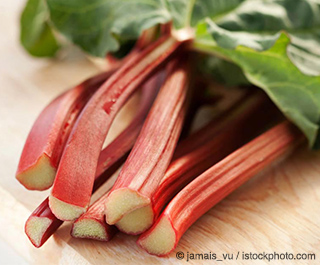Radical Rhubarb
Botanical name: Rheum Palmatum

When describing rhubarb, some might begin with its long, slender green and red stalks,1 accompanied by large, ruffled green leaves.2 While legally classified a fruit, rhubarb is technically it's a vegetable.3
Rhubarb may have gotten its start in Mongolia, and is now popular throughout Siberia and North America. Some say rhubarb is excruciatingly sour, which it can be if not prepared to its greatest advantage.4 It is compatible with numerous foods, and can be added to a wide array of dishes, making a rhubarb patch a garden essential.5
Rhubarb is most often served cooked in some manner because of its incredibly tart flavor when eaten raw.6 While you can find recipes featuring raw rhubarb, they often involve soaking it in honey or another natural sweetener to make it palatable.7 As for the sweetener, keeping it as minimal and as organic as possible is always the best rule of thumb for optimal health.
Health Benefits of Rhubarb
Every 100-gram serving of rhubarb provides 29.3 micrograms of vitamin K, which supports healthy bone growth8 and may limit neuronal damage in the brain,9 even to the point of Alzheimer's prevention.10 It contains infection-fighter vitamin C,11 along with vitamin A, another powerful natural antioxidant for good skin and mucous membranes, good vision, and possible protection against lung cancer.12,13
Rhubarb has folate, riboflavin, niacin, B vitamins and pantothenic acid. Good mineral sources include 12 milligrams of magnesium per 100-gram serving, along with iron, potassium and phosphorus.14
While many believe milk to be the best source of calcium,15 1 cup of cooked rhubarb contains 83 milligrams, which is impressive in itself.16 In fact, Michigan State University lists rhubarb as one of the top "fruits" you can eat to get your regular dose of calcium.17 You can refer to the table below for more information regarding the nutrients in rhubarb.18
Rhubarb Nutrition Facts
Serving Size: 3.5 ounces (100 grams), raw
| Calories |
93.61 |
|
| Calories from Fat |
0 |
|
| Total Fat |
0 g |
|
| Saturated Fat |
0.053 g |
|
| Trans Fat |
0 g |
|
| Cholesterol |
|
|
| Sodium |
4 mg |
|
| Total Carbohydrates |
4.54 mg |
|
| Dietary Fiber |
1.8 g |
|
| Sugar |
1.1 g |
|
| Protein |
0.9 g |
|
| Calcium 86 mg |
Iron |
0.22 mg |
Studies Done on Rhubarb
Using the premise that rhubarb is one of the oldest and best-known traditional Chinese medicines, researchers tested it against the Coxsackie virus, a known foot-and-mouth disease. A rhubarb root extract showed "significant inhibitory" effects against the disease, leading to the conclusion that further health benefits from rhubarb on a broad scale could have potential.19
In another study, rhubarb was shown to convey beneficial gastrointestinal results when given to patients with severe burns, with the result that it eased abdominal distension, promoted regularity and increased food tolerance2.20
Rhubarb Healthy Recipes:
Rhubarb, Strawberry and Mint Limenade

|
Ingredients:
|
|
✓ 250 grams rhubarb, chopped
|
✓ 200 grams strawberries
|
✓ 2 liters filtered water
|
|
✓ 2 tablespoons raw honey
|
✓ 1 handful fresh mint leaves
|
✓ 3 limes
|
Procedures:
- Wash the rhubarb stalk. Discard the leaves and snip the bottom of the stalks. Chop the stalks into small pieces.
- Remove the top of the strawberries and thinly slice them.
- Add the chopped rhubarbs and strawberries into a pot and squeeze two limes.
- Add 250 milliliters of water to create a strong lemonade base.
- Add the honey and bring the mixture to a boil.
- Once the pot is boiling, lower the heat and let the lemonade simmer for 15 to 25 minutes. Afterward, let it completely cool and add the rest of the water.
- Add the freshly sliced lime, some more strawberries (if you like) and the mint leaves into glasses.
Note: You can place the rest of the lemonade in a big container, along with the strawberries, lime and mint. However, you will need to remove them from the juice after two days to prevent spoilage.
(Recipe adapted from Yummly21)
Rhubarb Fun Facts
Rhubarb's history goes back a long way. In ancient Chinese medicine, rhubarb was used to help reduce fever and promote blood circulation and general cleansing.22
A good thing to remember is that rhubarb leaves are toxic, due to its oxalic acid content. Don't worry too much, however, because you would need to consume several pounds of rhubarb leaves before you suffer from the effects of too much oxalic acid in your body.23
Heralding spring,24 rhubarb is a surprisingly easy-to-grow vegetable.25 It grows well in fertile, well-drained soil, abundant garden compost26 and full sunlight,27 and it can yield an abundant harvest with very little care required. Once harvested, it can be refrigerated for two to four weeks when wrapped with a damp cloth to preserve humidity.28
Summary
Rhubarb is arguably one of the most delicious plants that signal the arrival of spring. Easy to store in your refrigerator, you can enjoy it while the snow falls, too. Best of all, the slender red and green stalks contain a singular set of nutrients that make it a healthy vegetable.
We owe a debt of gratitude to ancient Chinese medicine for its rhubarb remedies that lead scientists to discover the benefits of it the plant, such as fiber for better cholesterol levels,29 vitamin K for healthy bone growth30 and neuron function in the brain,31 natural antioxidants from vitamins C32 and A (which may help in the development of healthy skin), mucous membranes, vision and potential cancer protection.33
Other vitamins, minerals and phytonutrients in rhubarb, including outstanding amounts of calcium, offer essential support and optimal health benefits throughout the body, making this food much more than just a great dessert.34 Just be sure to consume it properly to avoid the oxalic acid.